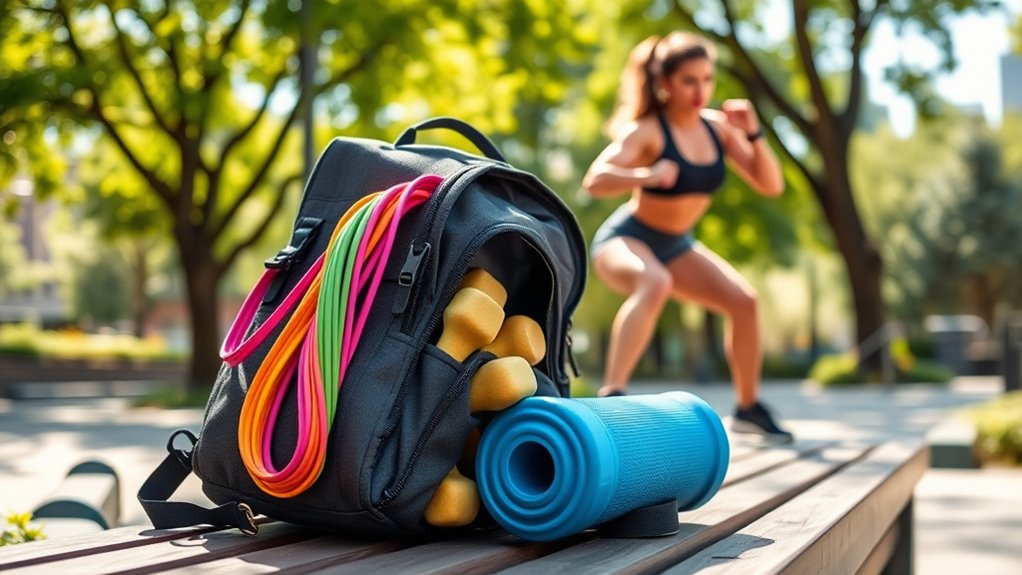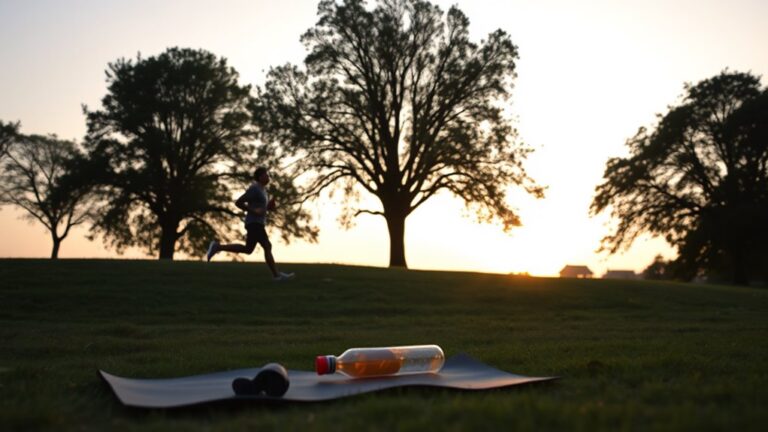You can easily use a backpack for strength training on the go by choosing one made of durable, lightweight materials. Pack it properly by distributing weight evenly and using compartments for organization. Incorporate bodyweight exercises like push-ups, squats, and lunges with added resistance from the backpack. For cardio, try jogging or interval training with it. This approach not only enhances strength but also boosts endurance. Stick around to discover more effective workout techniques and tips!
Nomad Highlights
- Adjust the backpack’s weight to enhance bodyweight exercises like squats, push-ups, and lunges for added resistance during workouts.
- Utilize multiple compartments in the backpack to stabilize and organize your gear, ensuring even weight distribution for safety.
- Incorporate resistance bands alongside the loaded backpack to increase workout intensity and versatility in exercises.
- Perform upper body workouts by lifting the backpack for shoulder presses, enhancing strength training on the go.
- Engage in cardio by jogging or hiking with a loaded backpack, elevating heart rate while building endurance and strength simultaneously.
Choosing the Right Backpack for Strength Training
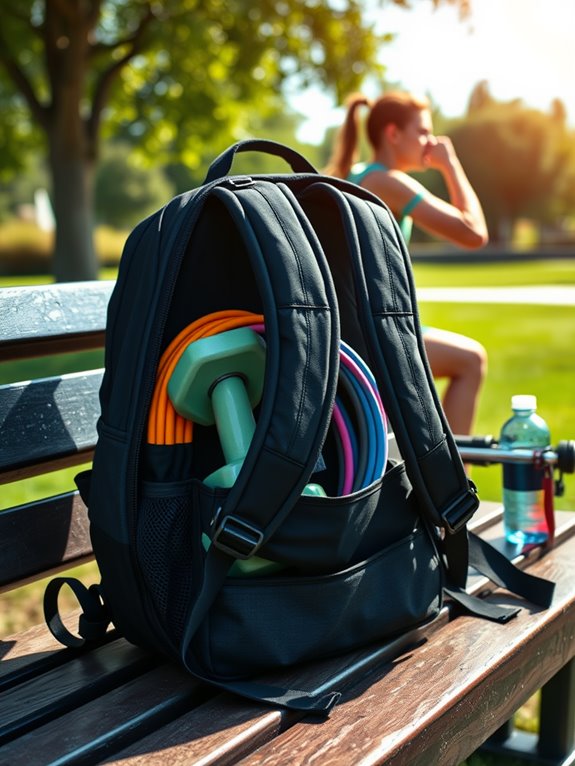
When you’re selecting a backpack for strength training, it’s crucial to keep both functionality and comfort in mind.
Look for durable backpack materials like nylon or polyester that can withstand heavy loads and resist wear and tear. These materials guarantee your gear stays protected during intense workouts. Furthermore, a lightweight design will facilitate easy transport, allowing you to carry your backpack comfortably during your training sessions. Additionally, incorporating compact designs can help you optimize your packing for maximum efficiency. The ideal size of your backpack should accommodate your equipment without being bulky, including options for adjustable dumbbells that offer versatile weight ranges. Consider including compact foam rollers for on-the-go recovery, as they can easily fit into your backpack and enhance muscle relief.
Adjustable straps and ergonomic designs can enhance comfort, allowing you to focus on your training rather than your pack. Investing in a durable backpack can significantly enhance your training experience and ensure longevity during your workouts.
Packing Your Backpack for Optimal Weight
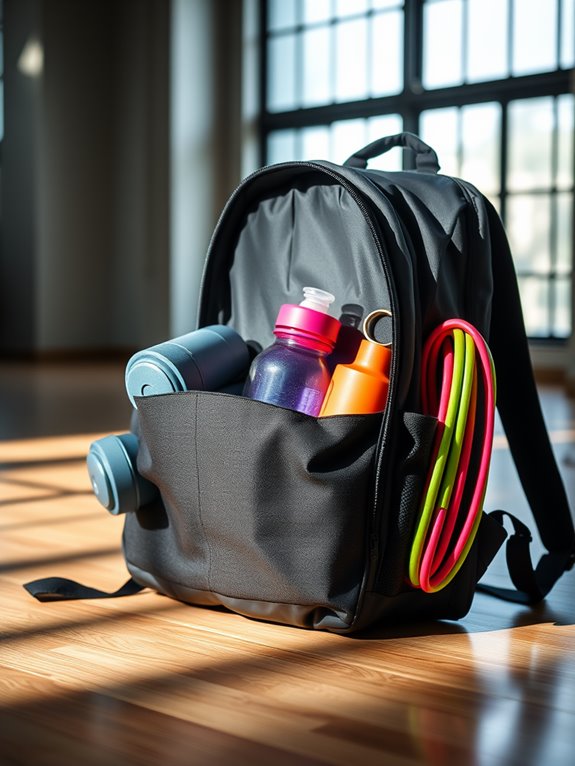
Packing your backpack for perfect weight can make a significant difference in your strength training routine.
To achieve ideal packing, consider the following tips:
- Distribute weight evenly: Place heavier items towards the bottom and center.
- Use multiple compartments: This helps stabilize the backpack weight and keeps items organized. Incorporating resistance bands in your backpack can enhance your exercise routine by allowing for versatile workouts. Additionally, having specific compartments for different weights can improve organization and efficiency during your training sessions. Resistance bands are an excellent addition to fitness regimens, enhancing workout routines across strength training, flexibility, and rehabilitation. Using unique products designed for specific hobbies can also help you find the best gear for your goals.
- Incorporate padding: Add clothes or a towel for extra cushioning, reducing strain on your back.
- Adjust straps: Make sure they’re snug to enhance comfort and prevent shifting during your workout.
Additionally, using ankle resistance bands can provide effective strength training on the go by targeting various muscle groups.
Essential Safety Tips for Backpack Workouts

When you’re using a backpack for strength training, proper weight distribution is key to preventing injury and maximizing your workout. Make sure the load is balanced and secure, so you can move freely and safely. Incorporating resistance training techniques using tools like resistance bands can enhance your overall performance and safety during workouts. Additionally, consider integrating compact massage guns into your recovery routine to alleviate muscle soreness after intense sessions. To further support your training, ensure you engage in biofeedback devices that can help track your progress and improve your workout effectiveness. Furthermore, utilizing collapsible trekking poles can provide additional stability and support during dynamic exercises outdoors. And always listen to your body—if something feels off, it’s best to adjust your weight or take a break. Regularly incorporating effective muscle targeting techniques can enhance your overall performance and safety during workouts.
Proper Weight Distribution
Achieving proper weight distribution in your backpack is essential for a safe and effective workout. When you load your backpack, focus on weight alignment to prevent strain and enhance performance.
Here are some tips to guarantee ideal load distribution:
- Place heavier items closest to your back for better balance.
- Distribute weight evenly across compartments to maintain stability.
- Use smaller items to fill gaps and avoid shifting during movement.
- Adjust straps for a snug fit, keeping the backpack high on your back.
Additionally, consider using unique products designed for strength training, as they can enhance your workout experience and safety. Incorporating ergonomically designed gear can further help in maintaining proper posture during your workouts. Proper weight distribution is crucial to reduce strain on your body, similar to the ergonomic benefits of using specialized equipment. Incorporating low-impact designs into your training can also help minimize strain on your joints during workouts. Furthermore, utilizing high-quality materials in your backpack can improve durability and support your training needs.
Listen to Your Body
Listening to your body is essential for ensuring a safe and effective workout while using a backpack for strength training. Pay attention to your listening cues—your body knows best.
If you feel discomfort or unusual fatigue, it’s a sign to adjust your routine or lighten your load. Body feedback is important; it helps you gauge your limits and avoid injury. Additionally, having a travel-sized first aid kit on hand can provide peace of mind during your workouts, ensuring you’re prepared for any minor injuries. A compact first aid kit can be especially useful for treating minor injuries quickly and efficiently. It’s also beneficial to choose a kit that includes comprehensive contents for a variety of injury situations. Consider also carrying a travel-sized hand sanitizer to maintain hygiene while on the go.
Start with lighter weights and gradually increase as you become more comfortable. Don’t push through pain; instead, modify your exercises to maintain proper form.
Incorporating rest days is also critical for recovery. By prioritizing your body’s signals, you’ll not only enhance your strength training experience but also foster long-term fitness success.
Additionally, using unique products that cater to your fitness needs can further enhance your workout efficiency.
Stay attuned, and your workouts will flourish!
Bodyweight Exercises to Pair With Your Backpack

To maximize your backpack workout, you can pair essential bodyweight exercises with your gear.
By adjusting the weight in your backpack, you can challenge yourself with movements like push-ups, squats, and lunges. Incorporating resistance bands can further enhance the intensity of these exercises, allowing you to target different muscle groups effectively. This combination not only builds strength but also enhances your overall fitness routine. Additionally, incorporating unique workout equipment can elevate your training experience and diversify your routine. Using water-filled dumbbells can also provide a soft and safe option for added resistance during your workouts. To ensure you are getting the most out of your workouts, consider utilizing structured training plans that can help monitor your progress and adjust your routine as needed. Furthermore, using adjustable dumbbells can provide a versatile option for strength training, allowing for gradual weight progression tailored to your fitness goals.
Essential Bodyweight Movements
Incorporating essential bodyweight movements with your backpack can elevate your strength training routine and enhance your overall fitness.
By pairing push up variations and squat techniques with the added resistance of your backpack, you’ll challenge your muscles more effectively. Here are some great exercises to integrate:
- Backpack Push Ups: Add weight for increased resistance.
- Backpack Squats: Hold your backpack close to your chest for added difficulty.
- Backpack Lunges: Step forward while carrying the weight to engage your core.
- Backpack Plank: Use your backpack as a weight on your back for stability.
These movements not only boost your strength but also keep your workouts fresh and innovative.
Embrace the versatility of your backpack and transform your fitness journey!
Backpack Weight Adjustments
Adjusting the weight in your backpack can greatly impact your bodyweight exercises, allowing you to tailor your workouts to your fitness level and goals. Utilizing unique products can enhance your training experience by providing innovative tools that complement your routine.
Start with a smart weight selection based on your current strength and desired challenge. If you’re new to strength training, consider lighter weights to build a solid foundation. Many individuals also find it beneficial to incorporate portable protein powder packaging, which can provide essential nutrients post-workout to aid recovery.
As you progress, make incremental adjustments to keep your muscles engaged and promote growth. For instance, add small items like water bottles or books for extra resistance during push-ups, squats, or lunges. This way, you can seamlessly shift from bodyweight to weighted exercises, enhancing your routine on the go. Remember, the key is to find that sweet spot where your backpack complements your efforts without compromising form. Additionally, incorporating incremental weight adjustments can maximize workout results through customized weight selection.
Upper Body Strength Training With a Loaded Backpack

While many people associate strength training with traditional weights and gym equipment, a loaded backpack can be an effective tool for enhancing your upper body strength. Incorporating portable dip bars into your routine can also diversify your workout options.
By incorporating this unconventional method, you can perform various strength exercises that target essential muscle groups. Here are some ideas to get you started:
Incorporating a loaded backpack into your workouts allows you to creatively target key muscle groups with effective strength exercises.
- Push-ups: Place the backpack on your back to increase resistance.
- Shoulder Press: Lift the backpack overhead for a challenging workout.
- Bent-over Rows: Lean forward and pull the backpack towards your chest, engaging your back and arms.
- Tricep Dips: Use a stable surface and place your feet on the backpack for added resistance.
Incorporating techniques like these can also improve your flexibility and recovery as you engage different muscle groups.
With these exercises, you’ll develop upper body strength while staying mobile and creative with your training!
Lower Body Workouts Using Your Backpack
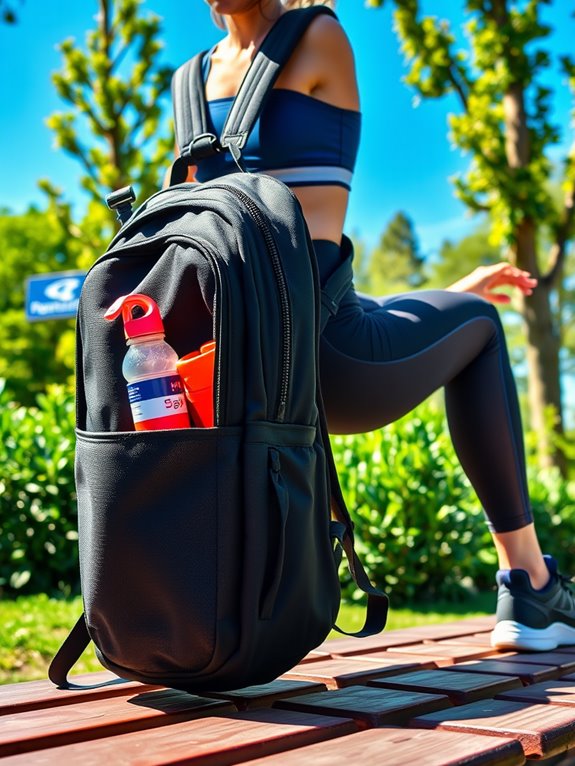
If you want to build lower body strength without traditional weights, using a loaded backpack can be an excellent solution.
Start with squat variations, like the backpack squat, where you hold the bag close to your chest or on your back. This adds resistance and engages your core.
For lunges techniques, try forward and reverse lunges while wearing your backpack; the weight will challenge your balance and stability. You can also incorporate lateral lunges to work those inner thighs.
Aim for three sets of each exercise, adjusting the load in your backpack as needed.
This innovative approach not only builds strength but also keeps your workouts fresh and dynamic, perfect for training on the go!
Core Strength Exercises With a Backpack

To effectively enhance your core strength, incorporating a loaded backpack into your routine can offer both versatility and challenge.
By using your backpack, you can engage in core activation and stability training while on the go. Here are some innovative exercises to try:
- Backpack Plank: Place the backpack on your back while holding a plank position to intensify the challenge.
- Russian Twists: Sit with your feet elevated and hold the backpack, twisting side to side for added resistance.
- Backpack Dead Bug: Lie on your back, hold the backpack above you, and alternate extending arms and legs.
- Standing Overhead Press: Press the backpack overhead while engaging your core for stability.
These exercises not only build core strength but also enhance your overall fitness.
Incorporating Cardio Into Your Backpack Workouts
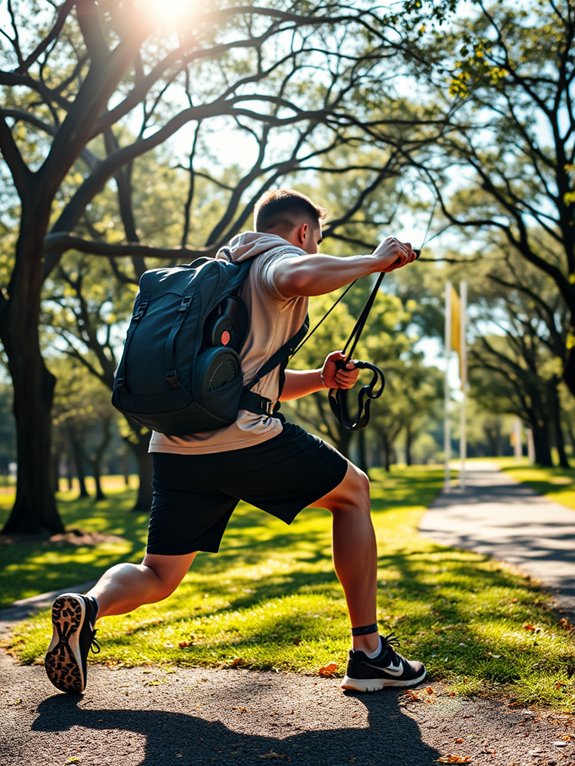
Incorporating cardio into your backpack workouts not only elevates your heart rate but also boosts your overall endurance and fitness levels. One effective way to achieve this is through backpack cardio, where you carry a loaded backpack while jogging or hiking.
Elevate your workouts by adding backpack cardio for improved endurance and fitness while jogging or hiking.
Try interval training by alternating between high-intensity bursts and low-intensity recovery periods. For instance, sprint for 30 seconds while wearing your backpack, then walk for a minute to recover.
You can also include exercises like jumping jacks or burpees in your routine, using your backpack for added resistance. This innovative approach not only keeps your workouts fresh but also helps you build stamina and strength simultaneously.
Get creative and make your cardio sessions engaging with your trusty backpack!
Creating a Balanced Workout Routine on the Go

While you’re on the move, creating a balanced workout routine with your backpack can be both practical and effective.
To keep your training dynamic and engaging, focus on incorporating a variety of exercises that promote strength, flexibility, and endurance. Here’s how you can achieve workout variety:
- Strength Training: Use your backpack as resistance for squats and lunges.
- Dynamic Flexibility: Incorporate stretches and mobility drills between sets.
- Core Exercises: Engage your core with planks or Russian twists.
- Cardio Intervals: Add jumping jacks or high knees to elevate your heart rate.
Frequently Asked Questions
Can I Use My Regular Backpack for Strength Training?
Yes, you can absolutely use your regular backpack for strength training! Just fill it with weights or heavy items to create resistance.
Focus on backpack exercises like squats, lunges, or push-ups while wearing it. Pay attention to weight distribution to guarantee you’re balanced and avoid strain.
This innovative approach lets you turn everyday equipment into a practical training tool, giving you the flexibility to stay fit wherever you are!
How Heavy Should My Backpack Be for Workouts?
When it comes to backpack weight, think of it as the anchor that keeps your workout grounded.
Ideally, your backpack should weigh around 10-20% of your body weight, depending on your fitness level. This range allows you to increase workout intensity without compromising form or safety.
Start lighter and gradually add weight as you build strength. Remember, the goal is to challenge yourself while still enjoying the journey to fitness.
Are There Specific Materials to Avoid in a Backpack?
When choosing a backpack, you’ll want to avoid materials like cheap polyester or flimsy nylon that can tear easily.
Instead, opt for durable fabrics like ripstop nylon or Cordura, which guarantee longevity.
Proper weight distribution is essential, so look for backpacks with reinforced straps and padded backs.
This not only enhances comfort during your workouts but also supports your strength training goals, making your experience more effective and enjoyable.
How Do I Prevent Back Pain While Using a Backpack?
You don’t want to feel like you’re carrying a mountain on your back!
To prevent back pain, focus on posture correction and weight distribution. Adjust your straps so the backpack sits comfortably, and distribute the load evenly.
Keep your spine aligned and use both shoulder straps for balance. When lifting, bend your knees instead of your back, and take breaks to stretch.
Your back will thank you for these smart choices!
Can I Use a Backpack for Outdoor Cardio Activities?
Absolutely, you can use a backpack for outdoor cardio activities! It adds resistance, making your workouts more effective.
Fill it with weights or gear to amp up your backpack cardio sessions. Whether you’re hiking, running, or brisk walking, a weighted backpack can enhance your endurance and strength.
Just make sure it fits well and distributes weight evenly to avoid strain.
Get creative with your outdoor workouts, and challenge yourself while enjoying nature!
Conclusion
By using your backpack for strength training, you can transform any ordinary outing into an extraordinary workout! With the right pack and a bit of creativity, you’ll build strength and endurance while on the move. Remember to prioritize safety and balance your routine with various exercises. So, grab that backpack and release your inner fitness warrior—your body will thank you as you conquer both your workout goals and your daily adventures!

